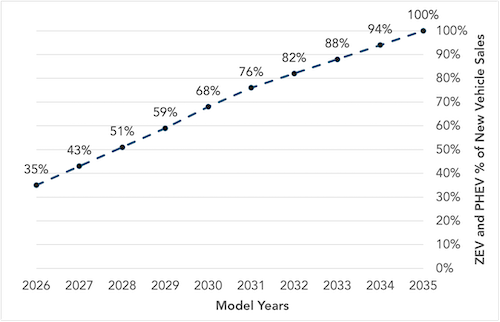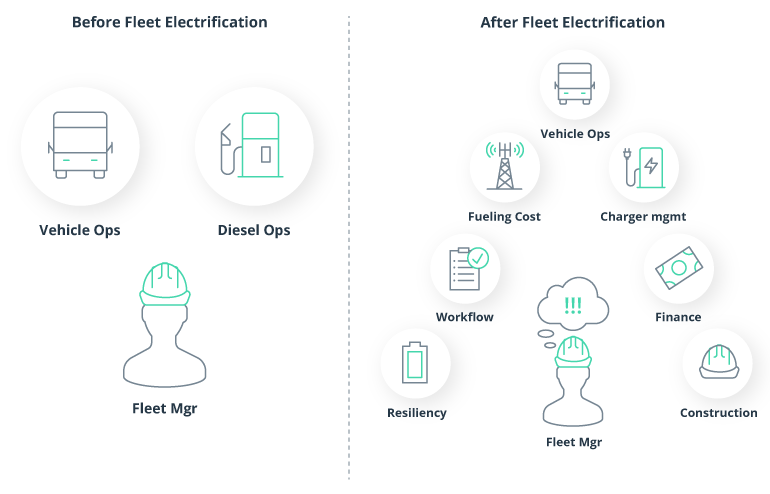The future is coming for Freight Haulers converting traditional diesel trucks to the Electric Zero Emission Vehicles (ZEVs) of the future.
Legislation by groups like the California Air Resource Board (CARB) is mandating the conversion of vehicles from traditional diesel haulers to electric vehicles for California Port Drayage by the year 2035.
CARB's Advanced Clean Cars II Regulations are ambitious and have their challenges in feasibility and infrastructure, but what does it mean when local freight services are eventually converted to include the core Over the Road (OTR), long haul services that still supply a huge segment of US freight needs?

Source: https://ww2.arb.ca.gov/our-work/programs/advanced-clean-cars-program/advanced-clean-cars-ii
Charging Infrastructure: A Critical Challenge
Immediately, the need for more charging stations is obvious.
In the California Drayage example, localized fleets with a domicile can logically recharge during “off hours," lessening the planning and service impact, assuming the necessary charging infrastructure is established.
However, with a typical range of 200-500 miles currently, OTR/long haul drivers will have to stop roughly two to three times as often compared to the range of a standard diesel estimated between 900-1200 miles per fill-up.
When it comes to route planning, knowing the location of existing charging stations is only a part of the equation. Depending on the type of charging station and the type of battery configuration used on a specific vehicle, different types of chargers can fluctuate between a half hour to an hour, to charge at a “fast” charging station and between 2-8 hours for some of the less advanced chargers. However, charge times of less than an hour only get to 80% of battery capacity.
Additionally, depending on your hardware and adapters, you may not physically be able to plug in at a given location based on the general connectivity options.
"With a typical range of 200-500 miles currently, OTR/long haul drivers will have to stop roughly two to three times as often compared to the range of a standard diesel estimated between 900-1200 miles per fill-up."
Impact of Queue Time on Charging Efficiency
Another factor that affects charging time is time spent in the queue. Queue time varies based on the number of chargers available, charging speed, time of day, and location/demand. In other words, you need more information than just an address (like diesel today) to know where you can “fill up.”
Due to the lower range of Battery Electric Vehicles (BEVs) today and the availability of charging infrastructure, factors that still affect diesel operations planning become significantly more magnified when creating route plans.
Road conditions and operating climate have a significant impact on charge duration during transit. For example, low temperatures cause degradation of over 30% of range. Wind and rain conditions—and something as simple as running the AC on warm days—also have a significant impact on overall range capacity and recharging requirements.
Reports like Effective EV Route Planning: How to Overcome Key Industry Challenges from Intellias have indicated the possibility that wind can be more impactful on energy draw than the grade of the road.

Source: AMPLY — Managed Charging Accelerates Cost & Health Benefits of EVs
Volodymyr Zavadko, a software delivery director at Intellias, says, "For example, driving an EV on a flat route with exposure to 8.5 km/h winds has been found to increase energy consumption by 14%, while driving on a longer hilly route with a lower wind speed increased consumption by only 5%. With a wind speed of 50 km/h, energy consumption increased by 31% and 15% (respectively) on the same routes."
"The state needs to install a biblical amount of infrastructure. We need a Manhattan Project of charging, according to Adam Browning, the executive vice president of policy at Forum Mobility."
Telematics and AI: Future Solutions
Longer term, onboard telematics and data, coupled with AI and Machine learning, will be able to help lessen the impact of variability when optimizing operating plans and fleet route designs. Data for charging locations and compatibility standards will become much more freely available.
In the short term, the simplest way to address the fluctuations in charging requirements caused by dynamic shifts in weather patterns and air temperature will be to initially overbuild the charging infrastructure, similar to the availability of diesel fueling stations today. Unfortunately, that infrastructure demand can’t be met overnight and requires huge amounts of investment and planning.
In a 2023 article from Wired titled Truckers Are Caught on the Front Line of California’s EV Push, Aarian Marshall notes, “The state energy commission has estimated it will need 157,000 more chargers dedicated to medium- and heavy-duty trucks by 2030—a target that would require building more than 450 per week."
Adam Browning, the executive vice president of policy at Forum Mobility, is quoted as having said, “The state needs to install a biblical amount of infrastructure. We need a Manhattan Project of charging.”
"Unfortunately, that infrastructure demand can’t be met overnight and requires huge amounts of investment and planning."
Economic Considerations for Fleet Operations
The basic Return on Investment or Total Cost of Ownership for Fleet Operations is a complicated equation as it stands—the infrastructure and energy production required to support this conversion by local and federal governments cannot be overlooked either.
The report from Intellias states, “In 2021, global EV fleets only consumed about 50 TWh of electricity (less than 0.5% of the total final electricity consumption worldwide). However, energy consumption will grow in proportion to fleet sizes. By 2030, EV fleets in the EU alone will demand 187 TWh. That’s over half of the energy the region consumed in 2022.”
While it is generally understood that charging electric vehicles can be half as costly, if not less, versus traditional fuels, demand more than tripling for electricity will surely drive up the variable expense, at least in the short term.
Adapting to an Electric Future
By nature, humans are often change-averse. While sometimes exciting, even small-scale changes are often “scary” for the population at large. This is not a “small-scale change” but more of an evolutionary leap for the global industry. With the seemingly inevitable migration to BEVs for both private and commercial/industrial applications, society is adapting to our new reality.
Our demand and desire to utilize cleaner energy to power our lives is outpacing our ability to provide it. However, the research on this topic is pretty clear that we are determined to get there and are asking the right questions.
While we might not get there on the schedules that are being proposed (even with individual user adoption and government legislation), I have faith, while balancing the reality of the requirements, that in time, we will get there.
"This is not a “small-scale change” but more of an evolutionary leap for the global industry. With the seemingly inevitable migration to BEVs for both private and commercial/industrial applications, society is adapting to our new reality."
About the Author
Adam Gray is a Supply Chain and Logistics Professional with 25+ Years of experience in the industry. His career started in Brokerage and Procurement, expanding to Fleet Operations, Warehousing, Transportation, Network Design, and Systems Implementation. When not solving Supply Chain issues, Adam can be found fishing and playing music as frequently as possible.